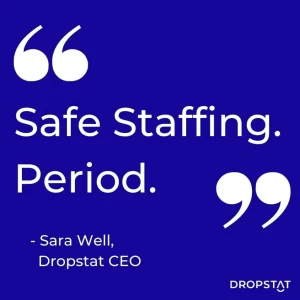WFO Meaning
Workforce Optimization Examples
How does WFO work on the ground? And how can it impact daily operations at your facility? Take a look at some of these down-to-Earth examples of how Workforce Optimization can transform your facility.
Scheduling Staff
A nurse calls in sick the morning before her night shift begins. Your scheduler has 12 hours to fill the shift with a replacement.
Scenario 1: The scheduler spends an hour calling, texting, and emailing nurses individually from the employee roster, only to receive a half-hearted maybe from one of them. Frustrated, they call back the “maybe” nurse and offer a $200 bonus to pick up the shift. The nurse accepts and the shift is filled, but at a high cost to the facility’s budget.
Scenario 2: The scheduler posts the open shift to Dropstat, their workforce optimization system, which sends a quick notification with the open shift details to all qualified nurses at your facility. Two nurses request to pick up the shift, and Dropstat’s AI automatically approves the first nurse. The scheduler spent 5 minutes working to fill the shift and the shift was filled within budget.
Workforce Expansion
Your facility is really understaffed and you need to hire additional nurses.
Scenario 1- You post a single full-time nurse job listing complete with salary, benefits, and sign-on bonuses to attract qualified candidates. The sign-on bonus is a bit of a budget stretch, but you really need to fill the position quickly.
Scenario 2: You take a deeper look at your staffing needs with Dropstat’s workforce analytics and discover that you’re not as understaffed as you thought you were. The data shows that you’re only struggling to meet patient needs on Sundays, Thursdays, and Fridays- but in two different wards. You conclude the best plan is to recruit two part-time nurses who will be able to help fill the staffing deficit better than a single full-time nurse.
Internal Staff Utilization
3 LPNs are unavailable to work for 2 full weeks- one is on vacation, another is sick, and the third is on family leave.
Scenario 1- You get one replacement LPN to cover most of the open shifts, but no other volunteers. So you fill in the remaining slots with RNs. The shifts are filled, but at a much higher cost to the facility’s budget and nurses’ satisfaction. Many RNs find it frustrating and unstimulating to fill the roles of LPNs.
Scenario 2- You reach out to your sister facility located a few miles away and “borrow” a couple of LPNs for the next two weeks. The LPN shifts are filled by LPNs within the budget, and RNs remain available to fill open RN shifts which require higher-level skills and training. This saves your facility money and maintains nurse satisfaction.
Why is workforce optimization important?
The overall goal of the workforce optimization system is to achieve organizational success by utilizing data and strategies in a way that:
- improves employee productivity
- improves patient satisfaction
- improves organizational efficiency
- decreases operational costs
- reduces human error
- maximizes tech investments
- automates processes
- streamlines every aspect of the company
Workforce Optimization (WFO) vs Workforce Management (WFM): What’s the Difference?
Simply put, WFO includes WFM capabilities, while offering much more. WFM is used to describe software that helps a facility with
- Forecasting demand
- Managing certain staff details
- Scheduling staff
- Understanding the facility’s performance
In contrast, WFO is a suite of solutions that includes the above in addition to
- Cost-efficient staff scheduling
- Gap Shift Management
- Workforce Analytics
- Turnover risk and retention strategy
- Cross-linking facilities for workforce expansion
- Incentivized employee engagement
- Avoidable cost containment
WFOs Create a Win-Win Situation for Management, Patients, and Staff
Let’s take a look at some other key benefits of workforce optimization techniques within your healthcare facility.
Management Will be Smiling
Lower costs and increase savings: By using a workforce optimization solution, you can be sure that you’re utilizing your available staffing resources to the max. You can double-check if there are other available staff to cover a shift before approving expensive overtime, and save money on every shift!
Avoid the many pitfalls of understaffing and opt for safe staff ratios that enable patient care to happen more efficiently and satisfactorily. WFO introduces automation into the staffing process and provides real-time guidance and actionable insights for savings opportunities so that your facility can staff safely without breaking the bank.

Patient Satisfaction will Skyrocket
WFO allows nurses to give patients their full attention, without trying to race between patients because they are stretched too thinly. Nurses’ full attention means fewer mistakes, especially with medication dosages, as well as better patient-caregiver rapport and overall improved quality of care. A happy patient often leads to a healthier patient, and healthcare facilities’ reputations are built and destroyed on patients’ experiences.
Staff will be More Effective
Healthcare staff that are more strategically deployed are better supported to do their work more effectively. Workforce optimization can slow employee turnover due to overwork as the staff is logically distributed to meet patient demands, reducing the strain on any single employee or team.
Many workforce management tools allow you to see when individual employees are overburdened and who might be available to help them out. By reducing an overly difficult workload, you also limit downtime due to absenteeism and fatigue.
Tips for a Smooth WFO Rollout
Utilizing technology to optimize your workforce is key to success, but it requires a gradual implementation process. And just as seeing results from WFO doesn’t happen overnight, so too the transition to WFO doesn’t happen overnight. Planning for a seamless implementation can be challenging for managers and staff. Here are some tips for creating a smooth WFO rollout with your employees.
- Be flexible with timing
Don’t make strict deadlines for program launches. More likely than not, this will lead to an overworked, stressed-out project team and frustrated stakeholders. Expect there to be hiccups at the beginning. Discuss the implementation plan with your team and build a plan to allow time to address unforeseen issues that allow staff to adjust where needed.
- Train your staff
Offering continuing education to your nurses boosts the feeling of value in your employees. It shows that you’re committed to building the skills and confidence of your workforce. It may also be a more efficient use of resources to invest in training an employee to take on greater responsibilities than it would be to hire an entirely new staff member to fill that managerial role.
3. Incentivize Employee Engagement
Change is hard, and getting used to new systems can be challenging for team members. Offering small yet enticing incentives (like gift cards) can sweeten the deal for even your most reluctant employees. Paving the path of least resistance is a recipe for success when trying to implement organizational change.
Dropstat’s Workforce Optimization Platform
With Dropstat, healthcare facilities can implement a cutting-edge, yet simplified approach to workforce optimization. You can utilize one unified platform to schedule existing staff first and fill in the gaps with the most cost-effective staffing choices. Utilize your workforce to the fullest, cut out unnecessary spending from your budget, and make data-informed decisions at every step.
Dropstat’s innovative workforce optimization solution identifies recurring staffing problems and suggests long-term staffing solutions. Working with Dropstat is the perfect way to automate cost-saving processes, optimize your workforce, and refocus on patient care and satisfaction.
Ready to be the best-rated healthcare facility in your area? We’re ready to work with your team.







